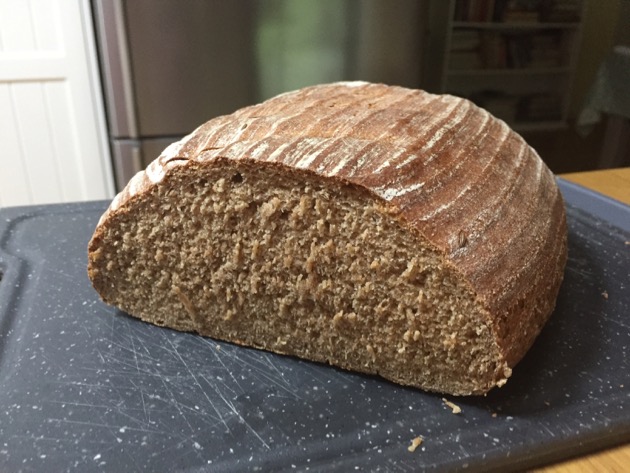I made this rye and spelt loaf yesterday. Hanno said it's as good as the one from the German baker. Woohoo!
Hello dear readers.
I'm back into my bread routine although I'm not baking bread every day, which is what I used to do. Now we eat our main meal at lunchtime and we don't need bread for sandwiches. This is a dense bread if you make it with rye and spelt - very much like traditional rye bread. It will be lighter if you add white or wholemeal flour instead of the spelt. Hanno likes a slice or two of good bread in the late afternoon which he eats with cheese, ham or smoked salmon. I had a slice of this last night with cheese and chilli jam. It was delicious.
It's important to use clean hands and clean utensils for this recipe. If you don't, you may introduce yeast or bacteria you don't want in the dough. You'll need clean bowls, measuring spoons and jugs and it's a good extra precaution to sterilise the jar you make the starter in. By using only the cleanest equipment, you'll end up with a very good dough that will bake well.
BUTTERMILK STARTER
I used a buttermilk starter dough to make this loaf and that was made by mixing one cup of rye flour with ¾ cup of buttermilk in a jar that can hold about 3 cups. Make sure you mix it well with a spoon because the starter needs oxygen. I left the open jar on the kitchen bench all day, at night I put it in the fridge. That slows down the fermentation and allows flavour to develop. Give it a good stir each morning when you take it out of the fridge. It's ready to use when you can see it's fermenting and bubbly. It takes between two to three days here but it will depend on the temperature in your kitchen. Please don't worry if the starter takes three or four days because the longer it takes the better the flavour will be. If, after three days, you see no activity, smell the starter and if it smells okay just add ¼ teaspoon dry yeast to the mix and stir. You should see fermentation start a few hours later.
RECIPE
1 cup spelt flour - you can use white or wholemeal if you don't have spelt
2 cups rye flour
water - enough to make the dough come together**
2 teaspoons salt - I use pink rock salt - optional*
1 tablespoon molasses or brown sugar - optional*
1 teaspoon caraway seeds - optional*
all the starter
*All the optional ingredients add a lot of flavour to the dough, use or omit depending on your taste and health requirements. I always use all of them.
Add your ingredients to a bread machine, adding about 50mls of water. Add the starter and start the machine on the dough setting. Check the dough after about a minute and add more water, bit by bit, until the dough comes together in a sticky ball.
When the cycle is finished, place the dough on a floured board, knead for a minute or two to make sure the consistency is right. It needs to be a firm dough because it won't be baked in a bread tin. Set the dough aside in a greased bowl or a banneton covered with a clean tea towel and allow it to rise. If you use rye and spelt it won't rise much, if you use white or wholemeal, which contain more gluten, it will rise but not as much as your normal white loaf. I baked my loaf after 60 minutes but this will depend on the temperature in your kitchen. Don't rush it by leaving it in a warm place, take your time and allow the flavours to develop - this is slow bread. Rye is always a sticky dough, so if it sticks to your hands, you're doing it right.
Preheat your oven to 220C/430F and prepare a baking tray with baking paper. When the dough has risen, plop the dough onto the baking tray and put it in the oven. After 10 minutes, turn the temperature down to 190C/375F and bake for about another 20 minutes. The loaf is ready when it smells like bread and there is a hollow sound when you tap the bottom of the loaf.
If you're looking for a healthy loaf with flavour and fibre, this is for you. I hope you try it. I'd love to hear how you go with it, so let me know.
I've changed this last paragraph because I used the wrong link. Here is a recipe for soft rolls like a brioche roll. I'll write about the other link soon. Happy baking everyone! 👩🍳🥖👨🍳
** this post was updated because I left out the water component.


